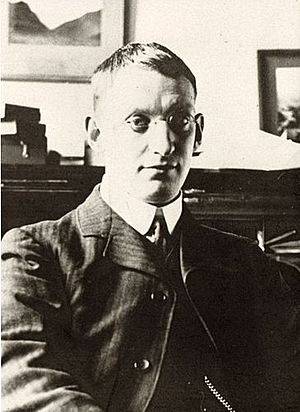Kenneth Mees facts for kids
Charles Edward Kenneth Mees (born May 26, 1882 – died August 15, 1960) was a smart British scientist. He was famous for his work with photography. He helped make cameras and film much better.
Contents
Early Life and School
Kenneth Mees was born in a town called Wellingborough in England. His father was a minister.
He went to the University of London to study. In 1906, he earned a special science degree. His big project was all about how photography works.
His Work
From 1906 to 1912, Mees worked for a company called Wratten and Wainwright. He helped create the first photographic plates that could capture all colors. These were called panchromatic plates. He also helped make special light filters and darkroom safelights.
In 1912, the famous Eastman Kodak Company bought Wratten and Wainwright. They really wanted Mees and his amazing skills. George Eastman, the founder of Kodak, convinced Mees to move to Rochester, New York. There, Mees started the Kodak Research Laboratories. He became its very first director.
Mees helped the United States military during World War I. He taught them about photography. After the attack on Pearl Harbor, Mees became an American citizen. This allowed him to work on important secret projects during World War II.
Later, he became a vice president at Eastman Kodak. He was in charge of all research and new ideas. He stayed in this important job until he retired in 1955.
During his career, Mees wrote many scientific papers. He also helped create very sensitive photographic films. These films were super useful for astronomy, helping scientists take clear pictures of space.
Mees was also the first president of the board for George Eastman House. This is a museum dedicated to photography. He held this role from 1947 to 1954.
He passed away suddenly in Honolulu in 1960.
His Family
In 1909, Kenneth Mees married Alice Crisp. They had two children together: Graham, born in 1910, and Doris, born in 1912. They were married for 45 years.
In 1951, Mees had a serious health issue with his leg. He had to have it removed. But he learned to use an artificial leg very well. He even managed to drive his own car.
Awards and Special Recognitions
Kenneth Mees received many awards for his important work. Here are some of them:
- Progress Medal from the Royal Photographic Society, Great Britain (1912 and 1952)
- Hurter and Driffield Medal (1924)
- Henry Draper Medal from the United States National Academy of Sciences (1936)
- Progress Medal from the Society of Motion Picture and Television Engineers (1936)
- Member of the American Philosophical Society (1937)
- Member of the American Academy of Arts and Sciences (1941)
- Member of the United States National Academy of Sciences (1950)
- Franklin Medal (1954)
- Fellow of the Royal Photographic Society
- Fellow of the Royal Society (1939)
- He was added to the International Photography Hall of Fame in 1972.
How He Is Remembered
Kenneth Mees's work left a lasting mark.
- The C.E.K. Mees Award is the highest research honor given by Kodak.
- The C.E.K. Mees Medal is given by the Optical Society of America. It is named after him and was started by his family.
- The University of Rochester's C.E.K. Mees Observatory is named after him.
- A crater on the Moon is named Mees in his honor.
- The Mees Solar Observatory on the top of Haleakala is also named after him.


